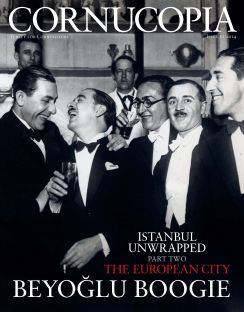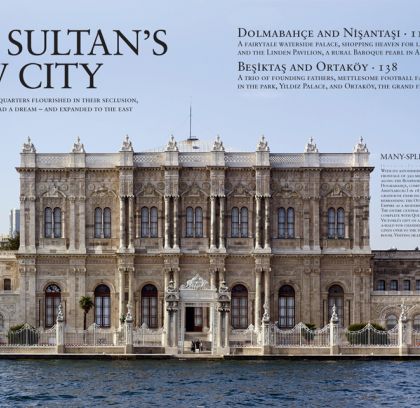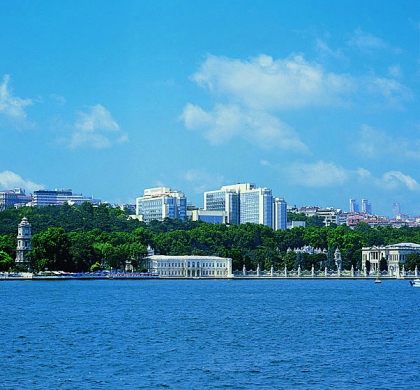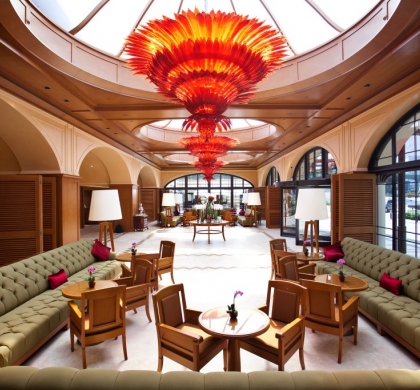Buy or gift a stand-alone digital subscription and get unlimited access to dozens of back issues for just £18.99 / $18.99 a year.
Please register at www.exacteditions.com/digital/cornucopia with your subscriber account number or contact subscriptions@cornucopia.net
Buy a digital subscription Go to the Digital EditionFrankie, on the rooftop of the Sofa Hotel, has a restaurant, bar and smoking lounge, all catering to a chic crowd, but one that doesn’t take itself too seriously. The vibe is 1970s New York, the days when Frank Sinatra penned his famous song (the restaurant is apparently named after him).
On the menu are dishes which fuse Turkish flavours with Mediterranean influences, dreamt up by head chef, Symeon Triantafyllou. The signature dish is the braised cheek of veal. Wines are matched by the renowned sommelier, Serdar Kömbe. There’s live music on Tuesdays, Wednesdays and Thursday from 10.00pm, with the programme curated by the Turkish pop singer, Sezen Aksu.
Biber Bar and Sess are other bars nearby. Meanwhile, Park Şamdan offers more elegant eating.
It was a time-honoured Istanbul dilemma that surfaced every time the question of where to go out for dinner came up. It was posed very simply. “Meat or fish?” Of course fish didn’t just refer to slippery, cold-blooded vertebrates that breathed through gills, and meat wasn’t simply meat. Both were shorthand for competing rituals.
The first was a meal cultivated by the former Greek communities up the Bosphorus (where they caught fish). It began with meze, was lubricated with anis-scented rakı and finished with a plate of seasonal fruit. Meat did, of course, mean meat – chunks of lamb baked in a clay oven, but more often beef or lamb turned into shish or meatballs and grilled over charcoal. Meat restaurants sprang up in the new suburban housing developments along the Sea of Marmara – which was also en route to the abattoir. Unlike fish, meat required something more toothsome and calorific to finish – something covered with sugary syrup or clotted buffalo cream. As for vegetarians… I am referring to an age when they didn’t exist.
This was a time when Istanbul families went out to dinner to eat things that were just too troublesome to cook at home. Frying fish in a brand-new apartment building was antisocial and inconvenient. Grilling over an open fire would rouse the fire brigade. There was the odd supper club or hotel dining room serving more European fare, but the fact that they served meat and fish meant there was something affected about them, alien and not quite right.
That age is long past. Shopping malls have pizzerias and sushi bars; there are chains of brasseries with eclectic menus that turn into nightclubs after ten o’clock. And the enigma of where to eat out at night has become far more complex. It is no longer a question of eating food you couldn’t imagine cooking in a domestic kitchen but of food whose preparation requires patience and skill and which you couldn’t imagine at all. Istanbul still has its genre restaurants but suddenly there are restaurants that are bending those genres (genre-benre-ing?). They even serve duck. Whereas once you might go out just to reassure yourself that the food you got at home was better, now you go to be intimidated.
There is a thin line, however, between the creative and the pretentious, and I would definitely place Gile in the former category. This is a small, elegant restaurant in the Akaretler neighbourhood of Beşiktaş, opposite the W Hotel. The starched linen on the table contrasts with rough, lime- washed walls. There are also huge oils, modern mantras by the sufic jazz musician Mercan Dede, but the principal decoration is a wine cabinet which occupies one whole side of the room. It all suggests seriousness of purpose rather than obeisance to fashion. The food takes its notes from Turkish traditions and ingredients, but is very purposefully constructed into structures on the plate.
And the flavours are subtle. Too often “new Turkish cuisine” means borrowing broad Mediterranean flavours of tomato and olive oil. Steak here comes with a delicate patchwork of thin Amasya apple confit and splashes of a date and rose cream. A rich chocolate fondant has a dusting of paprika and a scoop of hot red pepper flake ice cream. There is a good wine list and attentive waiters who explain what you are eating with the earnestness of a pupil determined to come first in the class. The chefs, Cihan Kıpçak and Üryan Doğmuş, are young veterans of some of Istanbul’s most upscale restaurants and here they have had the opportunity to develop a style all their own. There are quibbles – the amuse-bouches are the wrong side of spectacular. If you serve them at all it should be not just to whet the appetite but to excite expectations of what the kitchen can do. But, all in all, Gile is a landmark in a crowded Istanbul scene. And better still, it is comfortable and quiet – a place where you remember both the food and the conversation.
I have had two invitations to lunch from Ayşem Saraçoğlu, who manages the up-scale Frankie (rhymes with “swanky”) and have returned for dinner under my own steam. It occupies a high perch on top of the Sofa Hotel in Nişantaşı and, for a neighbourhood that looks in on itself, enjoys a pretty impressive view. The name is a tribute to Frank Sinatra, apparently, and the restaurant thus inspired has a reassuring, almost old-fashioned air of a crooned rendition of New York, New York. It is a haunt as much as a restaurant – a bar, a club, with an outdoor refuge for people who smoke and a romantic terrace with sofas wide enough for sleeping off the effects of the exotic cocktails. There is often live music after 10pm and the Turkish singer-songwriter Sezen Aksu is listed as creative director.
At the same time, Frankie takes its food seriously. The chef, Symeon Triantafyllou, has cooked his way around the Mediterranean Basin from Spain to Greece and the mise en place is bright and cheerful. There is also a ferociously competent sommelier, Serdar Kömbe, who helps Isa Bal, the Turkish-origin sommelier at The Fat Duck train for international competition. I enjoyed my steak tartare. I have yet to sample the braised cheek of veal, which would appear to be the signature dish. There is the odd bit of regional fusion, such as vine leaf and Chardonnay soup, but in the main part this is international cuisine with local notes. If Gile is the gastronomic equivalent of Nuri Bilge Ceylan – an attempt to introduce Turkish themes into a highbrow Northern European tradition – Frankie is Ol’ Blue Eyes singing ‘Never on a Sunday’. It sets out to entertain.
Meyhanes are the downmarket version of the Bosphorus fish restaurant, and Yeni Lokanta (the New Canteen) is a good example of what I call the modern meyhane – an attempt to breathe new life into the same-old-same-old meze tradition. There is a danger in innovation. When, for example, does a gastropub come out of the closet to admit it’s no longer a public house but wants to be a bistro? I think Yeni Lokanta has probably made the mental adjustment to realise it has severed its meze roots. For a start, you are not tempted to drink rakı with its array of “small plates”. You can order the meze in “sets” of three that appear to provide a foil of contrasting tastes, but each one is a self-contained dish in its own right. Meze don’t make sense on their own – you can’t have the sweet melon without the salty cheese; the oil of a braised vegetable needs the crisp sharp tang of an arugula salad. Even if Yeni Lokanta calls them meze, these are really hors d’oeuvres.
Not that they weren’t tasty. Curiously, the most pleasing dish to my non-Turkish guest was the simplest – grilled meatballs which, despite being kneaded with haloumi cheese and served with warm potato salad, were not much different from what you would get in any köfte restaurant. The mantı-dumplings filled with dried aubergine shells instead of meat was an intense savoury dish. Fried courgette flowers with yoghurt looks and sounds delicious but, alas, courgette flowers don’t actually have much flavour.
Main dishes were a slight disappointment. Octopus was a bit squishy and the oven-braised beef ribs were satisfying but not exceptional. All of this sounds ungracious. A lot of thought has gone into Yeni Lokanta – the decor has a comfortable 1950s feel, with a patterned encaustic-tiled floor and green glass lights hanging low over the tables, giving it the homely air of a Dutch café. Service is pleasant, the room is bustling and busy and not so crowded you can’t talk. There is a good selection of wine from the new crop of Turkish small producers. If it were your local gastropub, you’d feel yourself more than blessed. However, it is located at the Tünel end of Beyoğlu which, come to think of it, is where a meyhane ought to be.
None of the above are cheap by Istanbul standards, although with a bit of care, you can eat at Yeni Lokanta more reasonably. There is a tasting menu at Gile for tl170 – or tl270 paired with wine. Perhaps the next Istanbul dilemma is not meat or fish, but how much to spend.




 Issue 66, December 2023
Turkey’s Centenary Issue
Issue 66, December 2023
Turkey’s Centenary Issue

Cornucopia works in partnership with the digital publishing platform Exact Editions to offer individual and institutional subscribers unlimited access to a searchable archive of fascinating back issues and every newly published issue. The digital edition of Cornucopia is available cross-platform on web, iOS and Android and offers a comprehensive search function, allowing the title’s cultural content to be delved into at the touch of a button.
Digital Subscription: £18.99 / $18.99 (1 year)
Subscribe now